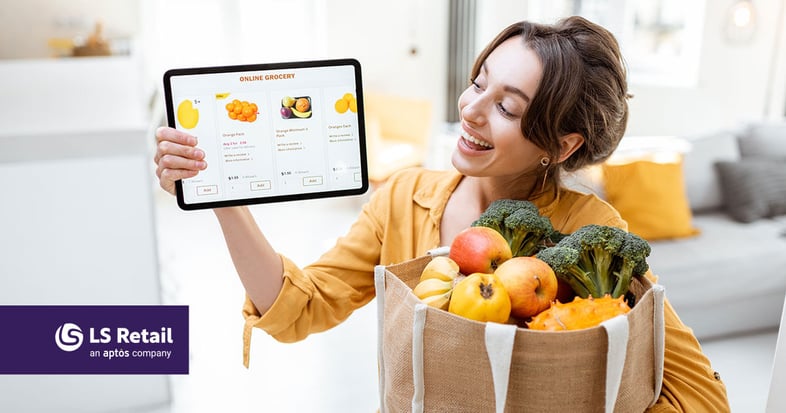7 tips to deliver better online grocery shopping

The number of people shopping for groceries online will only continue to grow in the coming years. McKinsey reports that online sales could account for 18-30% of the food-at-home market in some European countries by 2030. In North America, eCommerce for grocery is predicted to double in the next three to five years. In Asia Pacific, Forrester predicts continuous growth in the sector for the next five years.
Supermarkets have had time to prepare for the shift to online, but not all of them have stayed on top of trends. When, due to necessity, consumers worldwide moved massively towards online shopping, some supermarkets found themselves suddenly out of the race. Today, the businesses who didn’t believe and invest in omni-channel are facing the harsh consequences of their decisions.
Overall, online shopping has been gaining ground quickly, especially among different ages and geographies, so there's no reason to believe this popularity will fade in the near future. This means that there's no better time than today to invest in improving your e-commerce capabilities.
Here are seven tips to get you started.
1. Focus on speed and ease of use
Simplicity and usability of the platform should be your top goals:
- Make it easy for people to register, find the products they need, add items to the cart, review and edit the order and pay.
- Enable filtering per sub-groups of items to speed up search. Your customers would rather not have to scroll through a hundred-item long list of “bread and pastries” to find the apricot-filled croissants they are looking for.
- Make sure you include all relevant product information. Feature high-quality pictures, and clearly label brand names, price, ingredients with nutritional value and allergens, and pack size.
- Include expiry dates wherever possible. If a shopper knows that the Greek yogurt lasts three more weeks, they might buy three packs instead of one.
- Support returning shoppers. Give customers the possibility to recreate previous orders quickly and activate shopping lists where people can add staples and family favorites. Allow registered customers to see their buying history and to share the basket with other family members.
- Ensure short page load times. If your site is too slow to load, buyers may abandon their cart without completing the purchase.
2. State the important information up front
How annoyed will your online shopper be when he finds out that his postcode is not eligible for delivery, after he spent a full hour adding products to the cart? For retailers, it pays off to be clear and provide all the necessary information from the start. Buyers should be aware of shipping prices and times, delivery restrictions, geographical areas included in the service and special conditions before they have added a single item to their cart.
When it’s time to check out, make sure that all the steps are clearly labelled, and that shoppers know what’s coming up in the process. Consider adding lines that clarify where the customer is at, such as “You can still modify your order in the next step” or “By clicking here, you confirm your order and accept to pay. You won’t be able to modify your order afterwards”. Consider adding a progress bar that shows the various steps (“Customer details” → “Shipping” → “Payment information” → “Review order” → “Complete and pay”).
Once the order has been placed, include an “order completed” page where all the key information is summarized: items purchased, delivery and payment information, time of order, and what the customer should expect (an email? A call? A link to track the shipment?).
3. Think of the different platforms
Today, more consumers access websites from mobiles than from computers. According to data from marketing site The Drum, last year 63% of traffic and 53% of sales on retailers’ eCommerce sites happened via mobile. As the preference for mobile shopping is only going to get more common, you should ensure that your website performs well on mobile devices. Here are some questions you should ask yourself:
- Is my e-commerce site responsive?
- Are the buttons big and easy to tap? Are the text fields large and easy to type into?
- Are the pictures clear? Can people easily zoom in to see extra details? Is it easy to move through different images?
- Is all information visible on small screens, or do some lines disappear or end up off screen?
- Can customers easily move between items and categories?
- Is the payment process simple and easy to follow?
Many consumers start a transaction on a device and continue it on another one. If when they resume the transaction, they lose all the items they had already added to the cart, they may not be bothered to start over again – and you’ll lose that transaction. Enable saving the cart for logged in customers, so they can easily pick up transactions on different devices, at their pace and convenience.
4. Make it easy to navigate
On your e-commerce site you can easily display a larger product selection than in your physical locations. If you decide to go for the “endless aisles” style, make sure you organize the selection so that customers can easily find what they need.
- Offer top-level categories that can be accessed from the top menu.
- Enable customers to filter and sort items by price, brand, group, review scores, etc.
- Make sure information is easy to skim Use bullet points and organize information consistently (first ingredients, then package size, then weight, then expiry date…) so users can find what they need at a glance.
- Make sure the “buy” button is clearly visible. Add a checkmark or confirmation text to clarify when an item has been added to the basket.
- Include a search function with predictive suggestions and autocorrects (“Did you mean…?”). Your customer may call “cilantro” what you call “coriander” on your site; you wouldn’t want them to leave without it just because the search gave no results.
5. Offer flexible delivery
Offer several delivery options and time slots and be specific with your delivery times. The best practice is to offer precise delivery windows and allow people to pick the one that best fits their schedule. The more precise you are, the more likely your customers will decide to shop with you.
Nielsen’s “Global Connected Commerce Report” advises offering 30-minute interval windows – provided you can stick to your promises and ensure delivery within the selected timeframe.
How should you ship the products? Food retailers worldwide have been experimenting with different delivery methods. Which one(s) you should implement will depend on your customers’ demands, as well as on the local context and competitive landscape. Do your customers prefer to get their products delivered at home?
Would they rather use a third-party delivery station, such as a refrigerated locker? Do they want to order online and pick up in-store? Can you support picking up
products at the curbside, or even via drive-thru? The more delivery options you can offer, the likelier you are to satisfy all demands. What if you don’t have the infrastructure to manage timely delivery and distribution of your goods? Then you should consider partnering up with distribution agents. This model, made popular by tech companies like Instacart, has already been successfully adopted by many supermarkets.
6. Guarantee high quality
Research by Nielsen shows that concerns over the quality of fresh items and worries about the risk of spoilage during delivery are two of the main barriers to online food shopping. To help consumers overcome these concerns:
- Offer delivery options that preserve product quality. Refrigerated lockers, one-hour delivery, and click and collect within a specific pick-up window are some of the options to ensure freshness while offering customers high flexibility.
- Provide detailed information about fresh produce. This means including not only a description, but also freshness labels that say how many days the product will last after it is delivered.
- Solicit feedback, and feature customer reviews under each product on your website.
- Allow customers to exchange the products, or get their money back, if the food does not meet their expectations at delivery.
7. Make it all work together seamlessly
When you are selling products online, you will be judged for more than just the quality of your products. If your website crashes, if the delivery service runs late, if a product description is incorrect, if the refrigerated locker where you deliver products breaks down, customers will hold you responsible. Convenience is a core element in consumers’ decision to shop for groceries online. A poor experience, a snag in the process, and you risk losing a customer forever.
It pays off to analyze and future-proof your whole chain, from production, to the technology you use, to accuracy of product information, to physical delivery, and ensure that every step of the process is smooth, efficient, and up to standards.
Online grocery shopping has moved beyond its tipping point. Although it’s hard to predict what will happen tomorrow, we can expect that grocery e-commerce will continue its upward trend. Retailers who want to shape the market and win over competitors must move quickly and fearlessly. If you need advice getting ready for the digital future of grocery shopping, do not hesitate to contact us. We have helped many grocery businesses go from good to great.

